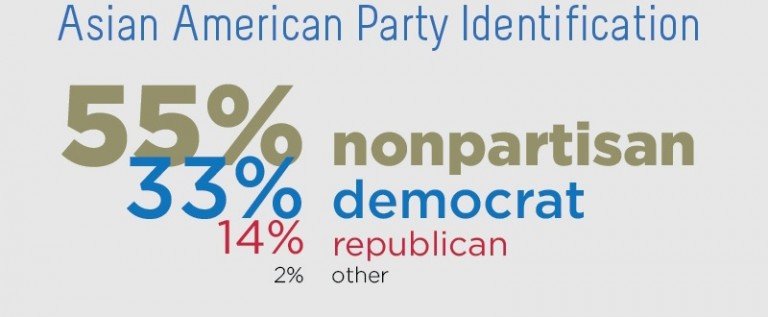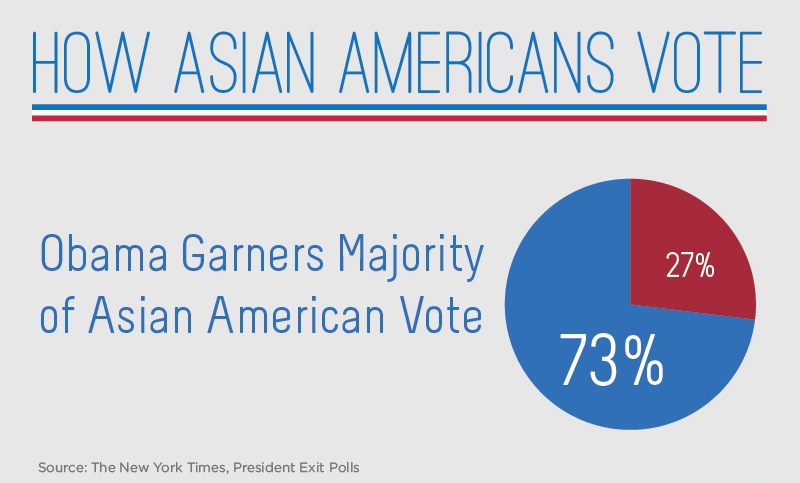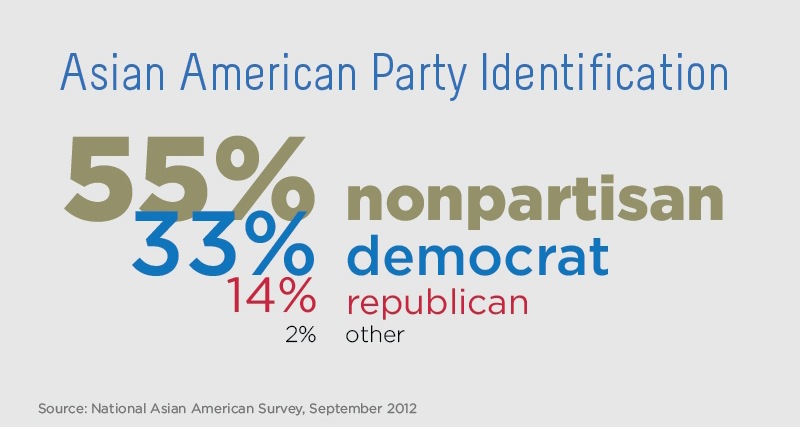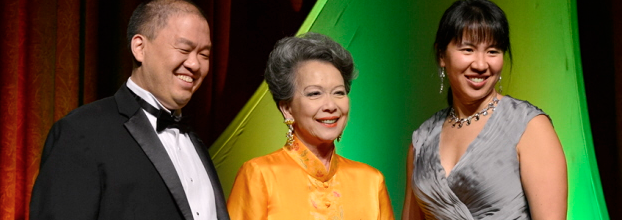Behind the Asian American Vote: Takeaways from the Nov. Election

Without question in the presidential election of 2012, Asian Americans made substantial inroads and left an indelible imprint on the nation. Thirty Asian American candidates ran for national office, the most of any election, with six candidates winning their seats. Furthermore, eight Congressional Asian Pacific American Congress members gained reelection, cementing the largest Asian Pacific American congressional delegation ever at fifteen.
Just as encouraging is that millions of Asian American voters turned out at the polls and contributed decisively to Obama’s reelection. According to exit polls, an overwhelming 73% of Asian Americans voted for Obama, with an estimated 3.2 million voters casting their ballot on Election Day.

The growing influence of the Asian American vote captured the national media’s attention. CNN, NPR, Politico, and other major news outlets eagerly discussed the growing influence of Asian Americans both at the polls and in higher political positions.
“This is probably the first time in our history where Asian Americans were spoken and discussed about as frequently as they have in mainstream circles,” said Bill Wong, a Democratic campaign strategist and director of the Asian American Small Business PAC.
So, what have we learned from this last election? Here are three main lessons we learned from the Asian American vote in 2012.
Lesson 1: While Asian Americans lean Democratic, many are nonpartisan.
With post-election results out, there’s no arguing that Asian Americans voted decisively for President Obama in November. In fact, over the last two decades they have made a large shift to the left, from 31% voting for Clinton in 1992 to 73% for Obama in 2012. However, making the quick assumption that most Asian Americans are Democrats ignores several key issues.
“Asian Americans are looking more and more clearly like a Democratic segment of the electorate,” said Taeku Lee, professor and chair of political science at UC Berkeley and co-Principal Investigator of the National Asian American Survey conducted pre-election in September. “At the same time, they remain reluctant partners in a Democratic coalition given the very high rates of uncertainty about how Asian Americans will vote and the very high rates of non-partisanship in response to the standard party identification question.”
Through the survey that Lee conducted along with Karthick Ramakrishnan of UC Riverside, they found that 51% of Asian Americans are non-partisan, higher than the average for the national population (which is as high as 40%). For comparison, 33% of respondents in the survey identified as Democrats and 14% as Republicans.

“The other big reason for this high rate of non-partisanship is that political parties have not invested that much into reaching out to and fully incorporating Asian Americans, at least at the local levels at which meaningful experiences are had and long-lasting relationships are forged,” added Lee.
And, here’s a really interesting statistic: 32% of National Asian American Survey respondents were undecided heading into the November election. The ramifications of this are significant, as it indicates that both parties had huge potential to tap into either unaffiliated or undecided Asian American voters.
“One thing for sure is [as] Asian Americans, we can really go both ways, left or right, and that really says a lot,” said Carrie Gan, Executive Director of the Center for Asian Americans United for Self-Empowerment (CAUSE). “Depending on where your focus is and how you phrase your message, you can reach the Asian American voters.”
Lesson 2: Both parties need to better understand Asian American voter issues
Pre and post-election surveys show that contrary to stereotypes that Asian Americans would favor the Republican platform due to their higher income levels, they ultimately leaned left due to a handful of issues, including—surprisingly—the economy.
“Asian Americans are often stereotyped as being entrepreneurial, meaning they must be pro-small business and anti-tax, leading people to believe they are for small government and more conservative-leaning in their stance—but that’s completely contradictory to how they voted,” pointed out Wong.
The AAI/AAJC/APIAVote post-election survey illustrated just that: for the 85% of voters in the survey who ranked the economy and jobs as “very important” to their vote, 70% voted for Obama and 30% voted for Romney. Following the economy, healthcare, education, and social security rounded out the issues Asian American voters considered most important in the post-election survey.
Additionally, based on the national surveys they conducted in 2008 and 2012, Lee and Ramakrishnan found that policies supported by or already enacted by the Obama administration on healthcare and education were heavily supported by Asian Americans. For example, Asian Americans strongly supported universal healthcare and the Affordable Care Act in 2012, were in favor of immigration reform, and supported increasing federal spending on education.

Further, President Obama’s excellent record of appointing Asian Americans to his staff certainly helped his cause. Over the course of his first term, he appointed three major Asian American cabinet secretaries (Steven Chu in the Department of Energy, Eric Shinseki in Veterans Affairs, and Gary Locke, former Commerce Secretary and now the US Ambassador to China), numerous high-level staff, and judges to the federal bench, alongside solid surrogate efforts through the Congressional Asian Pacific American Caucus whose members are heavily Democratic.
Lesson 3: Both parties need to increase voter engagement and outreach
While honing in on important issues and appointing Asian Americans that other voters can relate to are certainly successful avenues of engagement, directly contacting voters through grassroots outreach is often the first and most important line of communication.
Particularly in this last election, many organizations took action at the grassroots level to encourage civic participation among Asian Americans. APIAVote, AAJC, and other partners worked with over 75 organizations in 15 states on voter engagement initiatives.
The Asian American Legal Center, in conjunction with 13 other API organizations including CAUSE, conducted a Your Vote Matters 2012 Campaign that reached out to over 46,000 voters via phone banks and over 4,000 voters through canvassing and precinct walks in California.
Alongside grassroots outreach, having in-language resources was particularly important to reach out to as many ethnic groups and voters as possible.
“Having in-language volunteers and in-language material is very important,” said Gan. “They all have to have some ethnic-language component, because that’s the untapped demographic. There are a lot of voters who want to get involved, but just don’t have the materials or resources.”
Wong also highlighted the changing media landscape and the importance of reaching Asian American voters through different avenues.
“Now, campaigns have become more sophisticated with regard to online and mobile advertising through unique ways of promoting the candidates through social media, and using other types of avenues that Asians will spend more time on,” he said. “For example, they spend more time on social media and on the Internet than the average consumer.”
Perhaps most importantly, the results of this last campaign highlight the importance of campaigns strategically reaching out to voters directly on a large scale. Under the Obama campaign, Alissa Ko was appointed to lead the AAPI vote in the Western region, with outreach primarily consisting of meeting Asian Americans face to face and targeting the APA community in swing states. In contrast, the GOP seemed to lack a targeted, comprehensive effort towards garnering the Asian American vote.
Election 2016: Better Data, Support Networks
If the 2012 election was any indicator, the influence of Asian Americans in politics is growing and will continue to affect election outcomes. However, there is a lot more to learn about what motivates and interests the APA community.
Collecting better, more accurate data on the Asian American voting population is one step in the right direction. For example, the National Election Pool only reflected post-election data on the Asian American vote from three states.
Lee commented that one strong step forward would be to regularize data collection on Asian Americans in between four-year election cycles.
“The model I’d have in mind is something like the LatinoDecisions polls,” said Lee. “LatinoDecisions regularly monitors changes in the political opinions of Latino Americans and have done a great service to both public understanding and the sophistication of political campaigns in reaching out to the Latino vote. Building infrastructure like LatinoDecisions for the Asian American community obviously requires a dedication of resources that so far have been lacking.“
In terms of inspiring and supporting Asian Americans of all ages to pursue politics, organizations like CAUSE make a big difference. Through a variety of programs and outreach initiatives targeting diverse audiences such as women, young lawyers, and even Asian Americans in the military, the Los Angeles-based nonprofit aims to advance the political empowerment of the APIA community.
“I think the most important way of engagement is focusing on the individual,” said Gan.
“We give them opportunities such as research projects, where they’re actually writing letters or writing proposals, or they see a problem in the community and they want to actually make a change. “
Without a doubt, the 2012 election was a defining one for Asian Americans. Let’s hope that this is only the beginning of improved political representation for Asian Americans.





